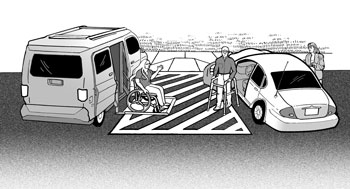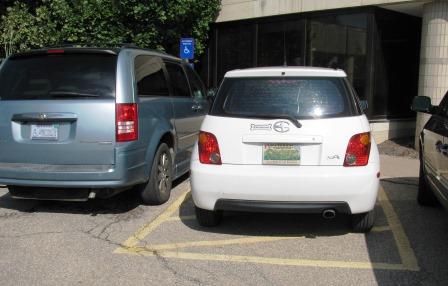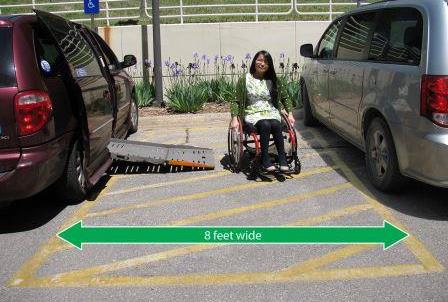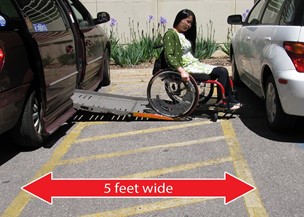Accessible Parking Etiquette: Honor the Aisles!
This information is available in PDF format upon request.
Access Aisles: Why They Exist
For many people with disabilities, access aisles serve a critical purpose. These striped aisles next to an accessible (or handicapped) parking space provide extra room so people can safely and comfortably exit or enter their vehicles. The access aisle provides room for people to:
- Lower their van’s ramp or lift
- Navigate with wheelchairs, scooters, walkers or canes

If this area is blocked even a small amount, a person with a disability who requires the extra space may not be able get out of his/her vehicle.
Or, if a person with a disability finds a car parked over or on top of an access aisle upon her return, she may have to wait hours until the violator moves his vehicle.

Access aisles are not intended for emergency parking, as shown in the violation above.
Accessible Parking Etiquette: Dos and Don’ts
Do display your accessible parking permit.
It is required by law that you display your accessible parking permit, including accessible parking placards or license plates, when you park. You may have a permit that legally entitles you to use the space, but if you don’t display it, you could be receive a ticket.
 Do leave van accessible parking spaces open for ramp- or lift-equipped vehicles.
Do leave van accessible parking spaces open for ramp- or lift-equipped vehicles.
Van-accessible parking spaces have a wider access aisle than standard accessible spots. The eight-foot-wide aisle provides enough space for a person who uses a ramp- or lift-equipped vehicle to lower the ramp or lift, then maneuver safely in the area between vehicles. A sign with the words “Van Accessible” and the international symbol of accessibility means the parking space is designed for ramp- or lift-equipped vehicles* (RLEVs).
In contrast, access aisles next to regular accessible parking spaces are only five feet wide, which is not enough room for wheelchair users to safely exit or re-enter a van that has a lift or ramp. In addition, there are fewer van accessible parking spaces than regular accessible parking spaces in a parking lot.
Although you do have the right to park in van-accessible spaces with an accessible parking permit, we encourage you to reserve van-accessible spaces for RLEV users if you can find a regular accessible parking space. Otherwise, RLEV users might not be able to find a parking space at all.
Do not use an accessible parking permit once it’s expired.
Accessible parking permits have expiration dates. Please be mindful of the expiration date of your placard or license plate, and do not use it after it’s expired. If you still need to use it after expiration, apply for a new one or renew it.
Do not let others use your accessible parking permit when you are not present.
The owner of an accessible parking permit must be present when using the permit. Do not lend your permit to your family members or friends so that they can use the accessible parking spaces. There might be legal consequences both to you and to the person who borrowed your permit, including a fine and your permit being revoked.
*RLEV = Ramp- or lift-equipped vehicle
Wide Access Aisles Versus Narrow Access Aisles
The following photo shows a van-accessible space, which is next to a wide (eight-foot) access aisle. The wheelchair user needs this much space to safely lower the ramp and exit and enter the van.

In the next photo, the van is parked in a standard accessible spot next to a narrow (five-foot) aisle. This does not allow enough space for the wheelchair user to safely exit and enter without possible damage to her wheelchair – or to the car parked nearby.

Please keep the access aisles completely open.
Even if you only parked over the aisle a small amount, you could restrict another person’s movement.
It might seem like access aisles cover a large area, but people with disabilities need all of the space to deploy their ramps or lifts. The wide aisle provides ample room to maneuver on and off a ramp or lift.
So stay within the lines and honor the aisles!
This brochure is made possible by a grant from the Dole Institute of Politics, with funding from the General Electric Company.
Endorsed by the Kansas Commission on Disability Concerns and the Kansas Association of Centers for Independent Living.
Produced by:
Research and Training Center on Independent Living
The University of Kansas
Rm. 4089,1000 Sunnyside Ave.
Lawrence, KS 66045-7561
Ph 785-864-4095 TTY 785-864-0706
Comments? Email rtcil@ku.edu
© February 2017